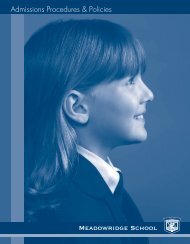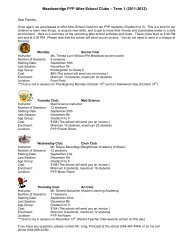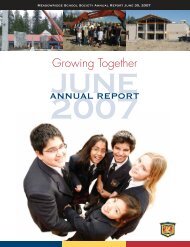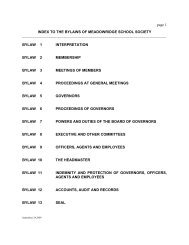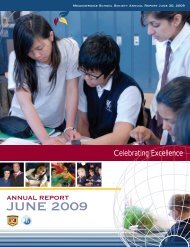January 2011 - Mini Gryphon.indd - Meadowridge School
January 2011 - Mini Gryphon.indd - Meadowridge School
January 2011 - Mini Gryphon.indd - Meadowridge School
Create successful ePaper yourself
Turn your PDF publications into a flip-book with our unique Google optimized e-Paper software.
Page 17 | JANUARY 2012 Las t year you helped us IMAGINE. This year, please help us DESIGN the nex t 25 year s.<br />
In nature, crystals are formed naturally from molten rocks (magmas), from hot<br />
aqueous solutions, or from hot gases. Well-formed crystals, frequently encountered in<br />
hydrothermal veins, are spectacular in form and color. Such crystals have always held a<br />
fascination for people. Throughout time, people have collected crystals, treasured them,<br />
studied them, and even ascribed magical powers to them.<br />
Mineralogy, the description and study of crystals, is one of the oldest scientif ic<br />
disciplines. Over the centuries, people have learned how to cut and shape crystals,<br />
generally by trial and error, to enhance their beauty and value, but the actual<br />
understanding of crystal structures, and classif ication of them, did not occur until the<br />
early twentieth century.<br />
The MYP 9 Science class has begun making their very own glow in the dark alum<br />
crystals. The students will take care of and grow their crystal for two weeks. The<br />
object is to try and grow the largest crystal.<br />
The f irst step to complete consists of creating the environment for the crystals to grow.<br />
This begins with students mixing ink from a f luorescent highlighter pen with hot tap<br />
water.<br />
Students will then slowly stir in alum, a compound that is used in the pickling of food.<br />
The alum, like sugar, will only dissolve so much, but when it has absorbed as much of<br />
the coloured liquid as it can the crystal grow th can then occur.<br />
Beakers are covered with a clean coffee f ilter or paper towel and taped to keep dust<br />
out. Crystals can begin to appear within one day.<br />
When all the crystals have grown and are dried, the Kindergar ten class will judge the<br />
best crystal. They are some very hard judges, so may the best crystal win!<br />
- Mr. Jamie Marriott, MYP Teacher<br />
On Wednesday, <strong>January</strong> 25, 2012, the Grade 7s had their f irst day in the lab with an experiment to learn about yeast grow th. Yeasts<br />
are eukaryotic micro-organisms, classif ied as fungi. In other words, yeasts are very tiny fungi. They feed on organic compounds (like<br />
sugar) and conver t it into carbon dioxide. Yeast is also used in traditional baking, as the yeast releases carbon dioxide gas the bread<br />
rises. Yeasts are uni-cellular organisms, and they do not need sunlight to grow and accounts for less than 1% of all fungal species.<br />
The lab was to determine and test the limiting factors of yeast grow th, things that affect whether the yeast lives or dies. These<br />
include factors such as the temperature of the water they live in, the type of food they are given, the amount of food they are given,<br />
or the quality of the water. Different groups developed different experiments to test these limiting factors.<br />
The students learned a lot. One group learned that yeasts grow best in sugary water, whereas yeasts living in salty water do not<br />
grow well. Baking soda (sodium bicarbonate) has about the same effect as salt. Other groups, which tested how yeast grew in<br />
different liquids, learned that, if fed sugar, yeast grows best in clear water. It doesn’t per form as well in apple juice or soda pop.<br />
- Nicolas, Grade 7 Student




